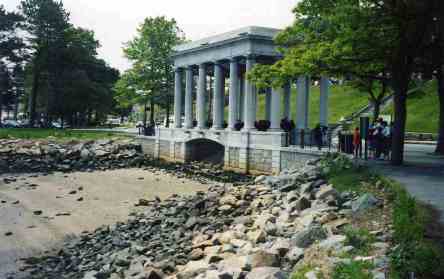
Plimoth Towne
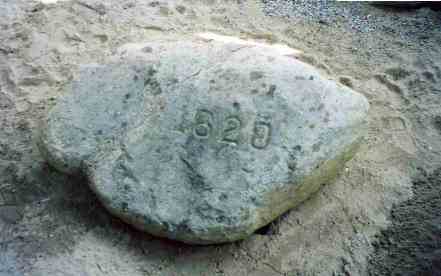
| Route 66 | Cities | Beaches |
 |
Plimoth Towne |
 |
| It all began with Plymouth Rock and 380 years later it still does. The town of Plymouth revolves around this old rock. It's the first place tour buses come. Every business in town locates themselves as "just up from The Rock," or "Two blocks from The Rock." And we suggest your day in town start here. It's not hard to find. Just come to the center of town, park at the dock, and here it is. In early June you can get to it easily, but by later in the Summer you'll have quite a line, sometimes over a block long. The rock is protected now, from people by a railing, from the weather by the fine marble portico, and from most seawater by its raised throne, although especially high tides and storms still dampen it. They were going to move it to the museum a century ago, but the rock wouldn't go, and when they tried to force it, it split (if you look carefully, you can see the crack in the photo above right). They took this to mean the rock wanted to stay in its beachfront location, so they built the structure around it. However, like a glacier, you only see the tip. 90% of Plymouth Rock lays buried in the sand. Much more of it was visible in 1620. |  |
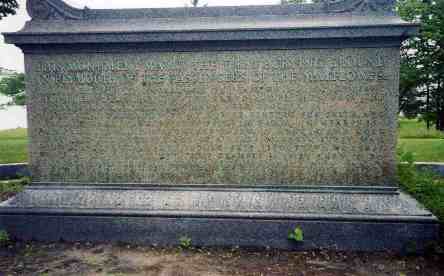 |
From Plymouth Rock, cross the street and climb the steps. This brings you to Coles Hill, a rather grim site. During that awful first Winter, when half the entire colony died, the Pilgrims were afraid to let the Wampanoag know how many were dying, so they buried the dead wrapped in blankets in the middle of the night in unmarked graves atop Coles Hill and tried to disguise the graves as gardens being dug, ignoring the obvious fact that it was midwinter and the natives were not stupid. Unfortunately, over the coming decades, well after Plymouth had become a village, the bones of those early victims began surfacing, often at the base of the hill after heavy rains. Everyone knew whose bones they were so they were collected over time and carefully preserved. Eventually the hill was excavated and the remaining bones gathered, cleaned, dried and added to the collection. Then, a Sarcophagus was built and installed atop Coles Hill. The bones of everyone were placed inside, and all their names inscribed on the outside. After the hill was excavated, it was built up, so today it is higher than it was during those early years. |
This is a depressing story, but climbing Coles Hill is worthwhile for several reasons. First, it is a reminder of just what a heavy price the Pilgrims paid to establish this colony, and how close they came to failing. Second, it is a reminder of why the Pilgrims truly believed God was on their side. They could see no other way any of them could have survived. Finally, Coles Hill is a great place from which to look around and see how the community is laid out, from the harbor below to the streets running up the hills toward the forest, and Towne Brook winding up to the right. Once they got past the first few years and had time build a real village, the Pilgrims established an official grave yard two blocks away called Burial Hill. But they continued to bury people in unmarked graves until 1650, then used wooden markers, which of course did not survive. The first stone grave marker was placed in 1681. Being meticulous record keepers, they left us a list of those buried, but no map, so descendants have no idea who is where. |
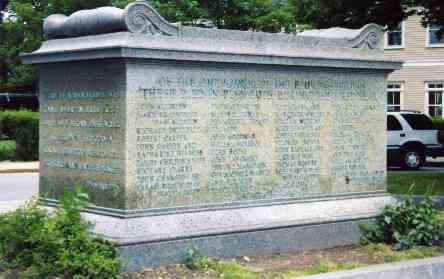 |
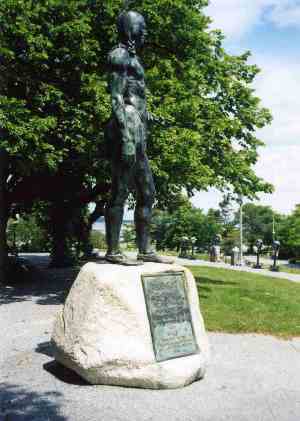 |
Also on Coles Hill is the Statue of Massasoit, the great Wampanoag chief without whose help the Pilgrims would not have made it through the Winter. It was ironic that Miles Standish was brought along with his cannon, muskets and powder, to defend the colony, but he instead became The Great Peacemaker, befriending Massasoit and guaranteeing that no attack came. As long as Standish and Massasoit lived, the peace was never broken. But there was a reason for this. Massasoit was 35 and recognized as a great chief, but he presided over a devastated people. Portugese fishermen introduced the Bubonic Plague, to which they had evolved immunity, but Native Americans had none. It almost wiped out the New England coastal tribes. The Wampanoag were reduced from 12,000 to 1500 between 1616 and 1619. Their bitter rivals to the West, the Naragansett, had been almost untouched. Massasoit was left with far too few warriors to hold off the Naragansett. He desperately needed a powerful tribe with which to ally. Then, one day, as if sent by the Great Spirit, a magic sailing ship appeared on the horizon. If you look South from the statue, past Town Brook, you can see Watsons Hill, where Hobomok's home and farm were. At Morton Park, at the upper end of Hobomok's farm, Massasoit and his men camped while talking treaty with the Pilgrims. Whenever Massasoit returned to Plymouth, that was where he camped, close to but outside the village. Other Wampanoag homes and farms were two miles South along the Eel River. As Plymouth expanded, Hobomok sold them his land and moved further out. It is Hobomok's farm which is re-created at Wampanoa adjacent to Plymouth Plantation, but the re-creation is along the Eel River. ManyWampanoag did farm there, but Hobomok was not one of them. |
| Come down off Cole's Hill and cross Leyden Street into Brewster Gardens, with Town Brook flowing through it. Herring have always come up this stream to breed, and the Wampanoag caught them for food and to place in hills of corn, squash and pumpkins for fertilizer. They taught the Pilgrims this trick, which allowed for the bountiful harvest leading to the famous First Thanksgiving. The mouth of Town Brook was deep and wide enough to admit a small sailing vessel. The Pilgrim Maiden Statue here honors the Pilgrim women. Scenic Town Brook Trail leads to Jenney's Mill. A front view of the mill is on the restaurant page. Shown here is the back, with the fish ladder leading up to bypass the mill wheel. Herring use this ladder to get to the lakes where they lay their eggs. The young then swim down the ladder and back to the ocean. This was the first mill built in America, and allowed the Pilgrims to grind their corn into meal, which they could easily store for their own use or ship back to England for sale. You can take a tour of the mill, buy a bag of freshly ground corn meal, and eat in the restaurant. | 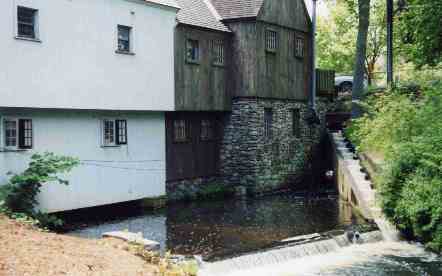 |
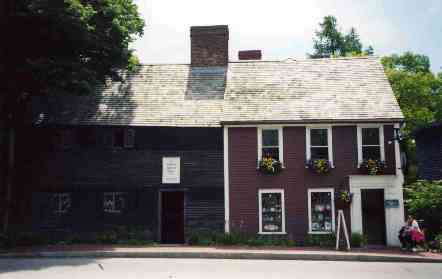 |
From Jenney's Mill, take the walk around to Summer Street. Across from you is First Church, and next to it is Burial Hill, the first official graveyard. These four Summer Street houses were built in 1640. These were the first homes in Plymouth to replace thatched rooves, which you see on all the Plantation homes, with shake shingle rooves. The Sparrow House, left, offers rotating special exhibits. It houses a pottery and adjoining craft gallery. The Alden House, right, still contains two private residences and has been in the same family for 370 years. | 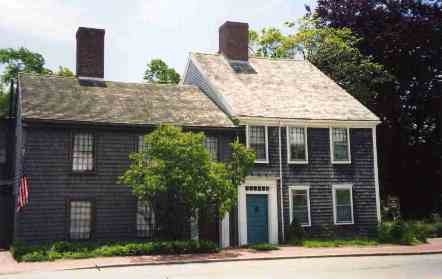 |
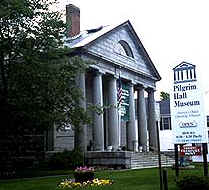 |
Walk down Main Street to Pilgrim Hall Museum. This opened in 1824 to house the incredible collection of artifacts kept by descendants of the Pilgrims. The Museum is still receiving donations of artifacts, and is planning an expansion which will almost double its size. This is the oldest public museum in America. It contains the most complete collection of authentic Pilgrim possessions including furniture, clothing, paintings, books, cradles, mugs, documents and weapons. Perhaps its prize is the relic of a ship that brought later colonists to Plymouth. Miles Standish's sword and John Alden's halberd are displayed. A slide show on Pilgrim history is worth watching. The building itself is a historical masterpiece. There are worksheets for children and learning packets for school groups. The offices of The Pilgrim Society are here. Closes at 4:30. Adults $3.00, children 6-15 $1.00. |
 |
From Pilgrim Hall, two blocks further down Main Street and one block up Samoset Street brings you to the Forefathers Monument. It is definitely worth a visit. 81 feet high, it is the largest granite monument in America. It took 30 years to build and was completed in 1889. The statue was designed by Boston artist Hammatt Billings and sponsored by the Pilgrim Society. This was the original prototype for the Statue of Liberty. |
| Back down on Water Street, you might wind up your tour of the town with a stop at the two early houses still maintained near the Mayflower. These are from the shakeroof period, built in the 1640s. There is a gift shop in one and the other is simply on display. This pair of houses is interesting because they were the beginning of the historical restoration of what is now Plimoth Plantation. When the foundation first began, they acquired and restored these two homes. Then they gradually grew into the world class living history museum seen today. | 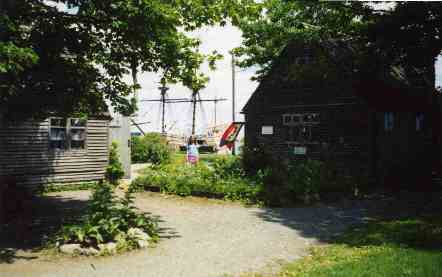 |
| As you leave town, drive South to the Miles Standish Homestead State Park and take a look at the Miles Standish Homestead. It's still a residence, owned by descendants, so you can't get too close, but it's worth seeing. Standish, of course, lived in The Plantation along with everybody else, then moved up to a house on Summer Street, but finally as they grew confident there would be no attacks, people homesteaded larger tracts of land further out. This gave them access to good land, timber, water, and room for barns and sheds. | 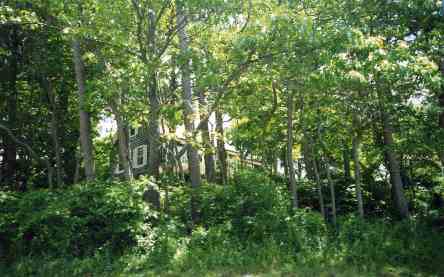 |
Standish, who eventually remarried after the death of his wife Rose and Priscilla Mullins' decision to marry John Alden, remained the de facto Captain of the colony's militia. He was addressed by that title in all documents until his death. But in fact he made a very good living as a gentleman farmer, held various positions in town government, and often met with Massasoit or other Wampanoag or Pekoset leaders. Usually when the Pilgrims sent hunting parties into the forest for game they asked Standish to accompany them for safety. |
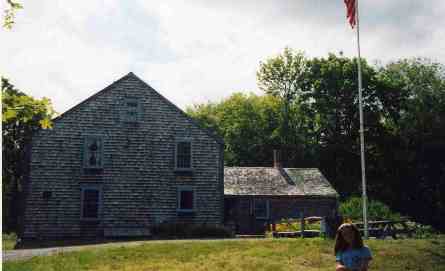 |
As you head up 3A toward Boston, stop at the John Alden Homestead. Like others, he and Priscille lived for a while in The Plantation, moved up to Summer Street, then homesteaded this beautiful tract of land in what is now Duxbury. Owned by the Aldens for 350 years, it is no longer lived in, and is open for tours. The family has incorporated as Alden Kindred of America, Inc., a nonprofit organization with its own foundation for the purpose of maintaining this house. It is a fitting finale to your Plymouth visit. Call ahead. 781-934-9092. | 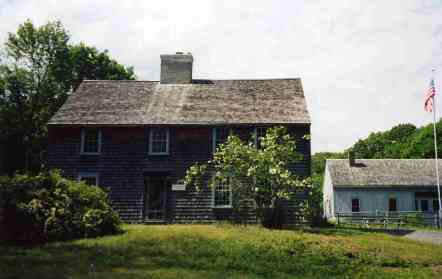 |
|
|||
|